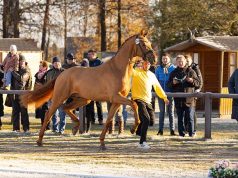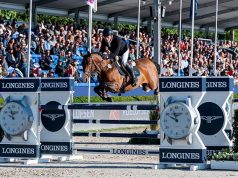By Åsa Gelinder Viklund, SLU / SWB
In 2013, the Swedish Warmblood Association (SWB) introduced linear scoring for three-year-old horses at the Young Horse Tests. It was implemented in the Riding Horse Tests and the Stallion Performance Test the following year.
Now, 10 years and 10,500 evaluated horses later, the system has proven valuable. In 2017, estimated breeding values (EBVs) for Swedish Warmblood riding horses based on the linear scoring evaluations were first calculated to assist breeders.
What is Linear Scoring?
Linear scoring provides a detailed characterization of a horse, not an evaluation of how good or bad the horse is. Over 50 traits are described on a nine-point scale from A to I, with A and I representing extremes, such as long vs. short, tall vs. short, etc. The middle of the scale, E, represents the average SWB horse. There are 21 conformation traits, 21 gait traits, 15 jumping traits, and one behavioral trait assessed. The purpose is to provide breeders, owners, and SWB with standardized, detailed information about a horse's characteristics.
Estimated Breeding Values
Estimated Breeding Values are derived from linear scoring and indicate how a horse is expected to pass on specific traits to the next generation. These EBVs are based on the horse’s own evaluation and those of its relatives. They provide insights into, for example, whether a horse's offspring will likely be robust or refined, take long or short strides, show bent or hanging forelegs when jumping, and more.
A value of 100 represents the average of all linearly scored horses. It’s important to note that a higher EBV does not mean ‘better’; it simply indicates a deviation from the average population. For some traits, a lower EBV may be optimal, while for others, values closer to 100 are preferable – for instance, traits related to leg conformation. These EBVs help breeders find stallions that enhance or complement a mare’s traits.
What is Optimal?
Currently, there is no universal standard for what is optimal in every aspect of a horse. However, a recent study examined what traits correlate with competition results. The oldest horses with linear scoring evaluations in the study were 11 years old, with some competing at advanced levels. All linearly scored jumping traits for jumping horses were significantly linked to later competition success. These relationships were linear; the closer a horse was described as ‘A,’ the more successful it tended to be. Certain conformational traits also correlated with better jumping results, such as a horse built uphill with a vertically set neck.
For gaits, an elastic canter proved beneficial for jumping horses. In dressage, many conformational and gait traits impacted competition success. Generally, traits closer to ‘A’ were favorable, but exceptions existed. Optimal traits included being neither pigeon-toed nor splayfooted, avoiding straight or sickle hocks, and having neither overly upright nor weak pasterns.
In gaits, traits like shoulder-free movement in trot were advantageous up to a point, after which they negatively impacted performance. Similarly, a slightly longer canter stride than average was beneficial, but an excessively long stride could hinder dressage performance. A new project aims to investigate if optimal traits for health and durability align with those for performance... To read the complete article you need to be a subscriber
CLICK HERE TO SUBSCRIBE TO BREEDING NEWS
SUBSCRIBERS CAN READ THE COMPLETE ARTICLE BY LOGGING IN AND RETURNING TO THIS PAGE



